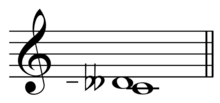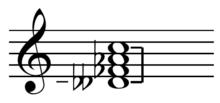Diesis


 |
Diesis (128:125) demonstration
The octave C-C', the three justly tuned major thirds C-E-G♯-B♯ and the descending diesis C'-B♯ are played (see example). |
| Problems playing this file? See media help. | |
In classical music from Western culture, a diesis (/ˈdaɪəsɪs/ DY-ə-sis; "difference"; Greek: δίεσις "leak" or "escape"[1]) is either an accidental (see sharp), or a very small musical interval, usually defined as the difference between an octave (in the ratio 2:1) and three justly tuned major thirds (tuned in the ratio 5:4), equal to 128:125 or about 41.06 cents. In 12-tone equal temperament (on a piano for example) three major thirds in a row equal an octave, but three justly-tuned major thirds fall quite a bit narrow of an octave, and the diesis describes the amount by which they are short. For instance, an octave (2:1) spans from C to C', and three justly tuned major thirds (5:4) span from C to B♯ (namely, from C, to E, to G♯, to B♯). The difference between C-C' (2:1) and C-B♯ (125:64) is the diesis (128:125). Notice that this coincides with the interval between B♯ and C', also called a diminished second.
The diesis is a comma. The above-mentioned 128:125 comma is also known as the lesser diesis, as opposed to a wider comma (648:625) known as greater diesis. As shown in the picture, in the quarter-comma meantone tuning system (a tuning system in which, by definition, major thirds are justly tuned), the diminished second coincides with the diesis.
| Diesis defined in quarter-comma meantone as a diminished second (m2 − A1 ≈ 117.1 − 76.0 ≈ 41.1 cents), or an interval between two enharmonically equivalent notes (from C♯ to D♭). |
Alternative definitions
In any tuning system, the deviation of an octave from three major thirds, however large that is, is typically referred to as a diminished second. The diminished second is an interval between pairs of enharmonically equivalent notes; for instance the interval between E and F♭. As mentioned above, the term diesis most commonly refers to the diminished second in quarter-comma meantone temperament. Less frequently and less strictly, the same term is also used to refer to a diminished second of any size. In third-comma meantone, the diminished second is typically denoted as a greater diesis (see below).
In quarter-comma meantone, since major thirds are justly tuned, the width of the diminished second coincides with the above-mentioned value of 128:125. Notice that 128:125 is larger than a unison (1:1). This means that, for instance, C' is sharper than B♯. In other tuning systems, the diminished second has different widths, and may be smaller than a unison (e.g. C' may be flatter than B♯):
- a greater diesis above unison (648:625) for third-comma meantone temperament (see below),
- a diaschisma above unison (2048:2025) for sixth-comma,
- a schisma below unison (32768:32805) for twelfth-comma, and
- a Pythagorean comma below unison (524288:531441) for Pythagorean tuning.
In eleventh-comma meantone, the diminished second is within 1/716 (0.0014) of a cent above unison, so it closely resembles the 1:1 unison ratio of twelve-tone equal temperament.
The word diesis has also been used to describe a large number of intervals, of varying sizes, but typically around 50 cents. Philolaus used it to describe the interval now usually called a limma, that of a justly tuned perfect fourth (4:3) minus two whole tones (9:8), equal to 256:243 or about 90.22 cents. Rameau, in his Treatise on Harmony (1722), names 125:148 ( [sic], recte 125:128)[2] as a "minor diesis" and 243:250 as a "major diesis", explaining that the latter may be derived through multiplication of the former by the ratio 15552:15625.[3] Other theorists have used it for various other intervals.
Greater and lesser diesis
Some acoustics texts use the term greater diesis[1] for the difference between an octave and four justly tuned minor thirds (tuned in the ratio 6:5), which is equal to three syntonic commas minus a schisma, equal to 648:625 or about 62.57 cents (almost one 63.16-cent division in 19 equal temperament). Being larger, this diesis was termed "greater" while the 128:125 diesis (41.06 cents) was termed "lesser".[4]
The small diesis ![]() Play is 3125:3072 or approximately 29.61 cents.[5]
Play is 3125:3072 or approximately 29.61 cents.[5]
Septimal and undecimal diesis
The septimal diesis (or slendro diesis) is an interval with the ratio of 49:48 ![]() play , which is the difference between the septimal whole tone and the septimal minor third. It is about 35.70 cents wide.
play , which is the difference between the septimal whole tone and the septimal minor third. It is about 35.70 cents wide.
The undecimal diesis is equal to 45:44 or about 38.91 cents, closely approximated by 31 equal temperament's 38.71 cent interval.
See also
References
- 1 2 Benson, Dave (2006). Music: A Mathematical Offering, p.171. ISBN 0-521-85387-7. Based on the technique of playing the aulos, where pitch is raised a small amount by slightly raising the finger on the lowest closed hole, letting a small amount of air "escape".
- ↑ Corrected in the English edition, Treatise on Harmony, translated with an introduction and notes by Philip Gossett (New York: Dover Publications, Inc., 1971), p. 30. ISBN 0-486-22461-9.
- ↑ Jean-Philippe Rameau, Traité de l'harmonie réduite à ses principes naturels (Paris: Jean-Baptiste-Christophe Ballard, 1722), pp. 26–27.
- ↑ A. B., "Diesis", The Harvard Dictionary of Music, fourth edition, edited by Don Michael Randel. Cambridge, MA: Belknap Press, 2003, p. 241.
- ↑ Hermann von Helmholtz, On the Sensations of Tone, 2nd English translation by Alexander John Ellis (1885), page 453. Quoted in the Tonalsoft Encyclopedia of Microtonal Music Theory.